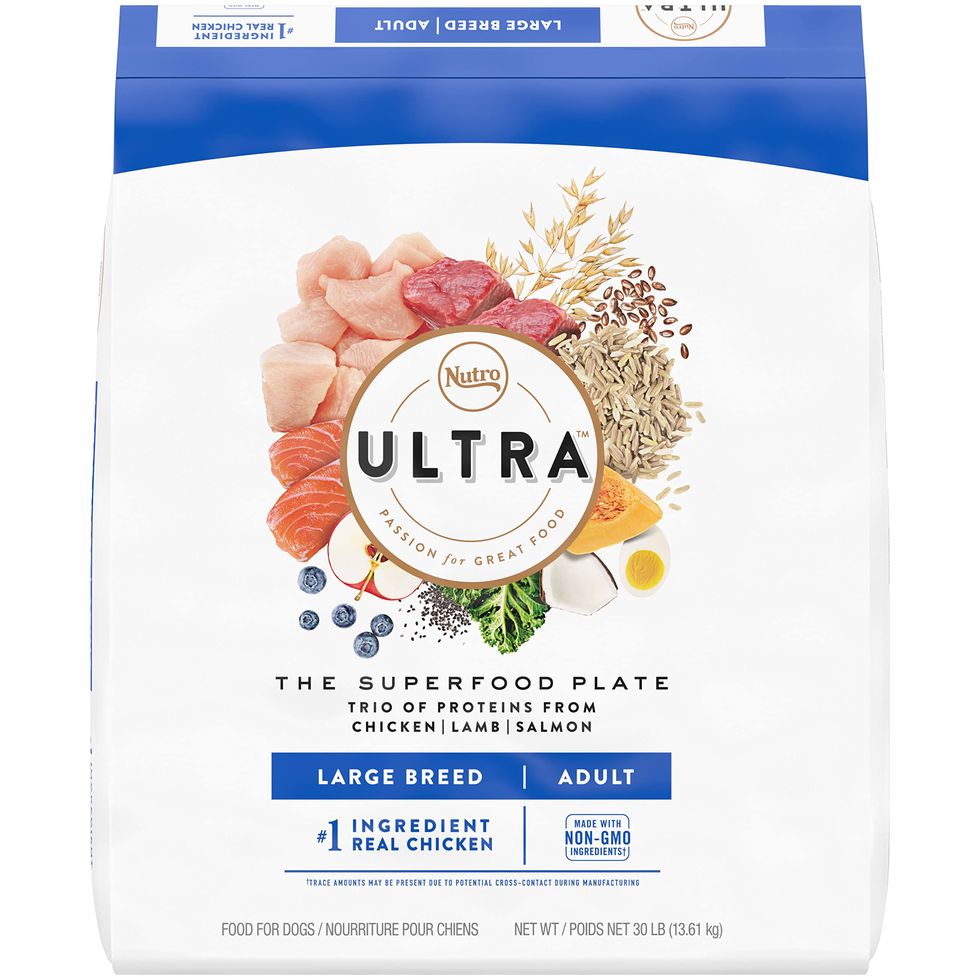Your dog deserves to eat good food. Although your dog may act as though the only food it wants is leftovers from your dinner, each dog is different and has varied nutritional demands. You should consider your dog’s age, size, and specific requirements while choosing the best dog food.
(For example, you may wish to search for the senior or small-breed varieties of some of the best dog foods on our list.) Therefore, it’s crucial to start by asking your veterinarian for recommendations in addition to our top choices.
Salmon, lamb, and chicken are combined together to create this multi-protein dry dog food. Since puppyhood, one of our pet professionals’ dogs has been eating this brand of food and continues to enjoy it.
According to Dr. Caos, “the crunch texture can help promote dental health,” just like other dry dog food. “The mechanical action of chewing kibble can help reduce tartar buildup and maintain healthier teeth and gums while the abrasive action of chewing can help scrape away plaque.” In addition to preserving those whites, this kibble contains the protein (each cup contains at least 22% crude protein) and what the manufacturer claims are “superfoods” such as grains, nuts, fruits, and vegetables. Numerous reviews have praised it, and it is slightly less expensive than other luxury brands but more expensive than the majority of typical grocery products.
We’re showcasing Nutro’s dry food for big dogs, but the company also sells Ultra varieties for small dogs, puppy and elderly dogs, weight management, wet food, and a limited-ingredient alternative for dogs with sensitive stomachs. We appreciate that Nutro is available on the internet, including Amazon, in pet shops like PetSmart, and at large merchants like Walmart.
2. Blue Buffalo Life Protection Formula
Although there are less expensive traditional dry dog foods available, we prefer Blue Buffalo because it offers high-quality ingredients at a fair price. First comes deboned chicken, then brown rice, chicken meal, and a mixture of barley, oats, and a variety of fruits and vegetables. To strengthen a dog’s immune system, the brand contains vitamins, minerals, and antioxidants. Many reviewers describe it as their dog’s favorite, and it has over 30,000 five-star ratings on Amazon.
Blue Buffalo is sold in a variety of locations, such as mass-retail chains, pet stores, supermarkets, and online. The adult chicken formula may be found at this link; Baby Blue puppy food is also available.
3. Ollie Fresh Dog Food
Fresh dog food costs more than regular kibble and needs to be frozen or refrigerated when it comes in the mail. Unfortunately, since the monthly cost varies according on your dog’s size and needs, you won’t be able to determine the actual amount until you give it a try.
Plans for small dogs start at less than $4 a day, according to the brand, and average $8 per day for all breeds. Get a plan tailored to your dog right now! The ease with which you may customize this dog chow for your pet is something our experts adore. We’ve even dubbed it the best dog food subscription box and our favorite dog food delivery service. You begin by answering a questionnaire about your dog that includes details about their breed, weight, age, level of exercise, and any dietary restrictions.
Ollie would then prepare and ship suitable prepared meals in flavors like chicken, turkey, pig, and lamb, saving you the trouble of finding the perfect food for your dog. The complete fresh plan, the mixed bowl of half fresh and half Ollie kibble, or a half-order of the fresh plan if you already have a favorite dry dog food are the three options available.
Ollie’s user-friendly website and app, which allow you to modify the delivery date or location, were especially appreciated by one of our analysts who used it for her picky dog. “I also love the compact packaging that doesn’t take up too much space in the freezer,” she says. “Food-wise, my super-picky Shiba seemed to like Ollie’s fresh food much more than she ever liked kibble.”
4. The Farmer’s Dog Fresh Dog Food
This well-known dog meal service was established in 2015 with the belief that homemade meals created with easily identifiable ingredients will benefit dogs, particularly those with food sensitivities. Pets with allergies or sensitivities benefit most from the Farmer’s Dog. The incredibly thorough sign-up quiz helps you focus on all the factors you need to take into account when choosing the best formula for your dog, including their activity level, pickiness, current food, health issues (such as allergies and sensitivities), body condition (skinny, just right, rounded, or chunky), and whether or not they need a prescription diet.
After completing all of that, The Farmer’s Dog will give you a suggested plan that includes up to three types of freshly made dog food that are flash-frozen. (We voted them the top delivery service for frozen dog food.) Pork, beef, turkey, and chicken are examples of protein. Interestingly, if you want to attempt making your own dog food at home, they will also teach you how to make it and sell you only the raw materials.
In any case, their membership is probably more costly than food from the market and less practical because you have to be home when it is delivered and put in the refrigerator or freezer. Plans begin at $2 per day, according to the company. The website uses the example of a 75-pound Labrador retriever mix whose fresh food plan is $10.39 per day and an 11-pound Yorkshire terrier whose fresh food plan is $2.80 per day to show how expenses might vary. If their dog thrives on it, fans think it’s worth the investment.
5. Purina Pro Plan
As one of the “most nutritionally balanced” products available, Dr. Conrad strongly suggests this brand. While EPA and DHA (found in salmon and fish oil) support heart health, omega-6 fatty acids assist maintain a dog’s skin and coat looking healthy and glossy. It is suitable for dogs with sensitive stomachs since it contains natural prebiotic fiber, which helps to promote digestive health by fostering beneficial intestinal bacteria.
According to the ingredient list, this choice primarily uses fish proteins along with a range of vitamins and minerals, including choline chloride to maintain the health of the pup’s liver and doses of vitamins E and A. Additionally, it is free of poultry, which some finicky puppies may appreciate.
Numerous other Pro Plan variations are available for dogs with various problems and sizes. A few of these are a beef-based high-protein mix, a large dog weight-management formula, and a puppy formula. A popular mass-market brand, Purina can be found online, at pet shops, supermarkets, and big-box retailers. You can also look at the Purina One line if you need to pay less.
What to consider when shopping for the best dog food
Even if you’re a vegetarian, your dog cannot be without animal protein. However, in addition to the meat, poultry, or fish that your dog eats for their primary food, cereals, fruits, and vegetables are all totally acceptable.
✔️ Trust the vet: “Your veterinarian can offer valuable guidance on selecting the right dog food and knows your dog’s specific needs,” Dr. Caos advises. “They can consider factors like age, breed, size, activity level and any health conditions in order to recommend an appropriate diet.”
✔️ Your canine companion will have opinions: You can introduce a dog to high-quality kibble, but you can’t guarantee that it will consume it. When experimenting with a new dog food, purchase a small bag because you might need to try a few tastes before you find the one they enjoy.
Look for a formula that works for them: Senior dog food is made to assist their joints, bones, and skin as they age, whereas puppy food may be made to aid in their growth. If you own a large dog, you should make sure that you’re buying dog food designed for large breeds because their nutritional balance differs from that of small breeds, which can be more susceptible to musculoskeletal issues, according to the American Kennel Club. On the other hand, smaller dogs benefit from a food that contains easier-to-eat kibble chunks.
Examine the list of ingredients: “High-quality ingredients [should be] the primary components of the dog food,” says Dr. Cao. “Ideally, the first few ingredients should be identified as sources of animal protein, including fish, meat, or chicken. Steer clear of items that list “meat meal” or other ambiguous words as the primary source of protein.
Additionally, your veterinarian can advise you on what to avoid with your dog. For example, while some dogs benefit from grain-free dog food, the majority of dogs do not require it. “If your dog has specific dietary restrictions or allergies, choose a food that accommodates those needs,” adds Dr. Caos. In an attempt to determine whether grain-free dog food was associated with canine heart disease, the FDA conducted an inconclusive research. Grain-free diets were not linked to the development of dilated cardiomyopathy (DCM), according to a more recent study from the University of Missouri. However, you should wait for your veterinarian’s approval before introducing your pet to a grain-free diet just to be cautious.
✔️ Receive expertly created recipes: You should seek for brands that use board-certified nutritionists to create the diet in order to guarantee that your pet is receiving the healthiest (and tastiest) food. This entails testing the food for pollutants and determining its nutrient content and sufficiency. Most well-known brands do this.

















